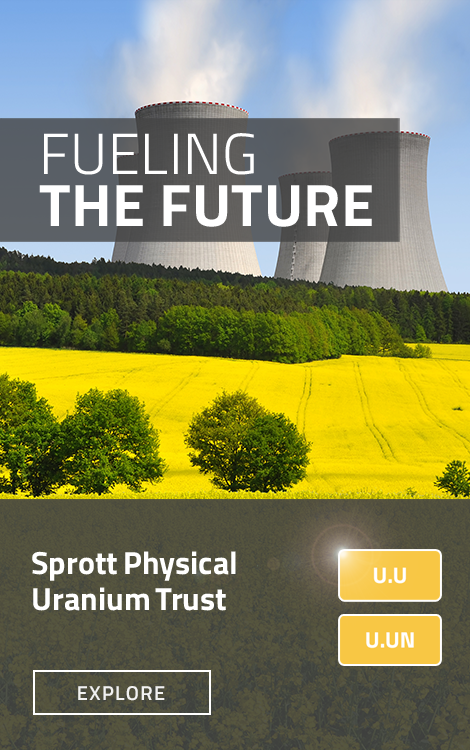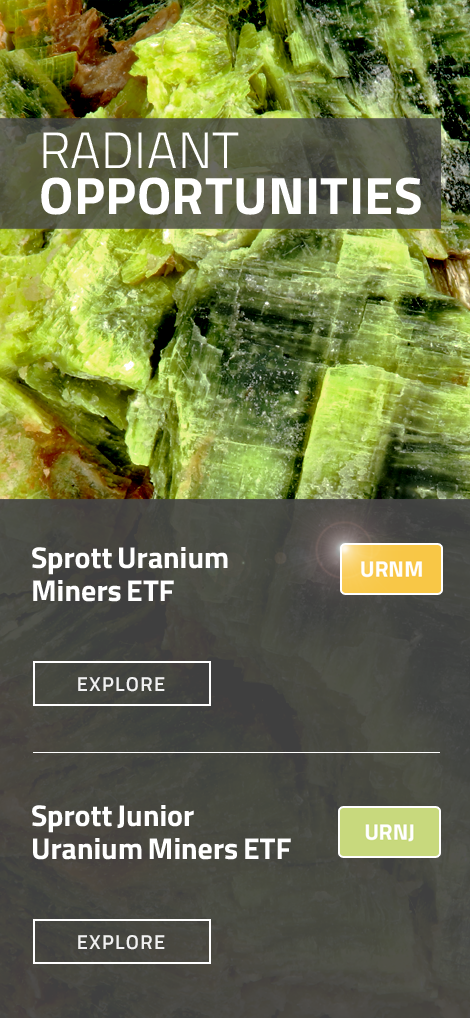Performance as of October 31, 2022: Average Annual Total Returns
| Asset | 1 MO* | 3 MO* | YTD* | 1 YR |
|
U3O8 Uranium Spot Price 1 |
8.32% | 7.57% | 24.12% | 17.30% |
|
Uranium Mining Equities (Northshore Global Uranium Mining Index) 2 |
3.11% | -3.30% | -6.38% | -18.44% |
|
Commodities (BCOM Index) 3 |
1.67% | -6.96% | 14.30% | 9.67% |
|
U.S. Equities (S&P 500 TR Index) 4 |
8.10% | -5.87% | -17.72% | -14.63% |
|
U.S. Bonds (Bloomberg Barclays US Agg Total Return Value Unhedged USD Index) 5 |
-1.30% | -8.23% | -15.72% | -15.68% |
Sources: Bloomberg and Sprott Asset Management LP. Data as of October 31, 2022.
*Performance for periods under one year not annualized.
October: Uranium Markets Brighten
Many asset classes rebounded in October following painful September drawdowns. The U3O8 uranium spot price climbed 8.32% in October, rising from $48.25 to $52.27 per pound. By comparison, the broader commodity markets gained just 1.67%. Among other asset classes, U.S. equity markets gained 8.10% as measured by the S&P 500 Index, and U.S. bond markets (Bloomberg US Agg Bond Index) lost ground on the back of rising inflation and the hawkish Federal Reserve. On a year-to-date basis, as of October 31, 2022, the uranium spot price climbed by 24.12%, making it one of the best-performing asset classes.
Uranium mining equities also posted positive results in October, with the Northshore Global Uranium Mining Index gaining 3.11% for the month. Miners’ overall results were impacted by the weakness in the stock price of index heavyweight Cameco Corp. (Cameco) following its announcement of a $US748 million stock sale to raise capital for its planned acquisition of Westinghouse Electric Company (Westinghouse) in partnership with Brookfield Renewable Partners (Brookfield Renewable). Year to date, uranium miners have lost 6.38%, which compares favorably to the year-to-date 17.72% drop in the S&P 500 Index.
Figure 1. Uranium Continues to Outperform in the Short Term (2020-2022)
This chart shows the relative outperformance of physical uranium and uranium mining equities over the past two years. 
Sources: Bloomberg and Sprott Asset Management. Data as of 10/31/2022. Uranium Miners are measured by the Northshore Global Uranium Mining Index (URNMX index); U.S. Equities are measured by the S&P 500 TR Index; the U308 Spot Price is measured by a proprietary composite of U3O8 spot prices from TradeTech; U.S. Bonds are measured by the Bloomberg Barclays US Agg Total Return Value Unhedged USD Index (LBUSTRUU); Commodities are measured by the Bloomberg Commodity Index (LLCBCOM); and the U.S. Dollar is measured by DXY Curncy Index. You cannot invest directly in an index. Included for illustrative purposes only. Past performance is no guarantee of future results.
Energy Transition Gains Momentum
The International Energy Agency (IEA) released its 2022 World Energy Outlook in October, further underscoring the importance of nuclear energy and uranium in supporting the world’s energy transition away from its dependence on fossil fuels and in ensuring higher energy security. According to the IEA, “Russia’s invasion of Ukraine has sparked a global energy crisis”. Russian sanctions and geopolitical maneuvering have tightened the world’s energy supply and caused energy prices to spike, stoking inflationary pressures and heightening the risk of recession. This energy deficit has created an urgent catalyst to embrace alternatives to fossil fuels and supports our thesis that nuclear power will likely be pivotal to the global energy transition.
The IEA has increased its forecasts of nuclear power, reporting that it expects nuclear energy generation to grow 53% from 2021 to 2050 based on current stated government policies in place, 84% based on announced government targets and 109% on its net-zero emissions by 2050 scenario. With nuclear energy’s generation potential to double by 2050, the uranium sector is likely poised to benefit.
Figure 2. Global Electricity Nuclear Supply by Scenario (TWh; Terawatt Hours)
Source: 2022 World Energy Outlook, International Energy Agency.
Positive Developments for Uranium Miners
On October 11, Cameco Corporation announced that it would form a strategic partnership with Brookfield Renewable Partners to acquire Westinghouse Electric Company.6 Brookfield Renewable will own a 51% interest and Cameco 49%. This acquisition marks the largest in recent history, with Westinghouse’s market capitalization of US$4.5 billion, not including debt, being nearly half of Cameco’s $9.8 billion market capitalization.7 Westinghouse operates as a downstream company providing nuclear operating plant services, designing and engineering new nuclear reactors and providing nuclear fuel services. The initial market reaction to the deal was negative, as Cameco’s stock slid 14% in response to the pricing terms of the bought deal stock sale. Cameco’s stock price recovered somewhat but remained down for the month. In our view, the acquisition is a healthy sign that the uranium industry is moving forward and is a vote of confidence from Cameco in the nuclear industry. The partnership represents a vertical integration across the uranium fuel supply chain that is likely to enhance Cameco’s ability to win new business.
The market reacted more favorably to Uranium Energy Corp’s completed acquisition of the Roughrider uranium development project from a subsidiary of Rio Tinto PLC, and Uranium Energy was the top-performing holding in the Northshore Global Uranium Mining Index for the month.8 Denison Mines Corp. (Denison) filed its environmental impact statement (EIS) on October 26.9 For Denison, this represents a crucial step in the permitting process to develop its Wheeler River uranium mine. NexGen Energy Ltd., another late-stage uranium developer, filed its EIS earlier this year.10
Energy Shortages and Rocketing Prices Support Uranium's Bullish Outlook
In our view, the October performance of uranium mining equities does not reflect the sector’s strong underlying fundamentals. Year-to-date as of October 31, U3O8 spot, conversion and enriched uranium prices have all significantly appreciated for both short- and long-term purchase contracts. By contrast, uranium miners remain in negative territory, as they have been impacted by weakness in broad equity markets and rising interest rates. Despite this, we believe that strong demand for uranium conversion and enrichment, coupled with a shift away from Russian suppliers, supports a further increase in the U3O8 uranium spot price, which is ultimately supportive of uranium miners.
Cameco, for example, continues to report strong growth in its portfolio of long-term uranium contracts as utilities are accelerating uranium purchases. In 2019, pre-COVID, Cameco estimated that, from 2020 through 2024, it had commitments to deliver an average of 19 million pounds per year.11 In 2021, Cameco added 30 million pounds in contracts. This year, Cameco is projected to add 77 million pounds in contracts. In its recent Q3 earning report, Cameco announced it has “advanced contracting discussions for about 27 million pounds of long-term uranium business and 7.5 million kgU (kilograms of uranium) of conversion services from initiation to accepted.” This is in addition to Cameco's uranium year-to-date contracts of 50 million pounds of U3O8 and 7 million kgU of conversion. The uranium contracts are expected to be finalized over the next few months, underscoring Cameco’s belief that the uranium sector is in the early stages of the contracting cycle.
Uranium Demand is Strong
We believe that uranium demand will continue to gain momentum, as many countries are seeing record-high electricity prices going into high-demand seasons. In addition, the security of the supply of nuclear fuel is paramount, as national grids rely on baseload nuclear power for stability, utilities are focused on replenishing inventory levels to ensure access to fuel and fuel costs have a relatively small impact on the overall profitability of nuclear power plants; historically, uranium demand has not been price sensitive.
We believe the uranium bull market remains intact despite the negative macroeconomic environment. There has been an unprecedented number of announcements for nuclear power plant restarts, life extensions and new builds that are all creating incremental demand for uranium. However, the current uranium price remains below incentive levels to restart tier 2 production and greenfield development. Over the long term, increased demand in the face of an uncertain uranium supply may likely support a sustained bull market. For investors, uranium miners have historically exhibited low/moderate correlation to many major asset classes, potentially providing portfolio diversification.
Figure 3. Uranium Bull Market Continues (1968-2022)
Click to enlarge this chart.
Note: A “bull market” refers to a condition of financial markets where prices are generally rising. A “bear market” refers to a condition in financial markets when prices are generally falling. Source: TradeTech data as of 10/31/2022.
In closing, we continue to believe that physical uranium and uranium miners are well positioned to take share within the energy sector as energy security and decarbonization increase in importance. With the number of nuclear reactors planned to increase by 35%, governments are signaling the need to embrace the reliable, efficient, clean and safe energy produced by nuclear to meet ambitious decarbonization goals. At the same time, a uranium supply deficit remains entrenched and uranium miners may be the recipients of increased investment, which may in turn bring the market back into balance.
| 1 | The U3O8 uranium spot price is measured by a proprietary composite of U3O8 spot prices from UxC, S&P Platts and Numerco. |
| 2 | The North Shore Global Uranium Mining Index (URNMX) was created by North Shore Indices, Inc. (the “Index Provider”). The Index Provider developed the methodology for determining the securities to be included in the Index and is responsible for the ongoing maintenance of the Index. The Index is calculated by Indxx, LLC, which is not affiliated with the North Shore Global Uranium Miners Fund (“Existing Fund”), ALPS Advisors, Inc. (the “Sub-Adviser”) or Sprott Asset Management LP (the “Adviser”). |
| 3 | The Bloomberg Commodity Index (BCOM) is a broadly diversified commodity price index that tracks prices of futures contracts on physical commodities and is designed to minimize concentration in any one commodity or sector. It currently has 23 commodity futures in six sectors. |
| 4 | The S&P 500 or Standard & Poor's 500 Index is a market-capitalization-weighted index of the 500 largest U.S. publicly traded companies. |
| 5 | The Bloomberg USAgg Index is a broad-based flagship benchmark that measures the investment grade, US dollar-denominated, fixed-rate taxable bond market. |
| 6 | Source: Cameco and Brookfield Renewable Form Strategic Partnership to Acquire Westinghouse Electric Company. |
| 7 | Source: Cameco to co-own Westinghouse Electric Company. |
| 8 | Source: PR Newswire: Uranium Energy Corp Completes Acquisition of the World-Class Development-Stage Roughrider Uranium Project From Rio Tinto. |
| 9 | Source: Denison Announces Significant Regulatory Milestone for Wheeler River with Submission of Environmental Impact Statement. |
| 10 | Source: NexGen Environmental Assessment (EA) for the Rook I Project (Project). |
| 11 | Source: Cameco Corporation 2019 Annual Report. |
Investment Risks and Important Disclosure
Relative to other sectors, precious metals and natural resources investments have higher headline risk and are more sensitive to changes in economic data, political or regulatory events, and underlying commodity price fluctuations. Risks related to extraction, storage and liquidity should also be considered.
Gold and precious metals are referred to with terms of art like "store of value," "safe haven" and "safe asset." These terms should not be construed to guarantee any form of investment safety. While “safe” assets like gold, Treasuries, money market funds and cash generally do not carry a high risk of loss relative to other asset classes, any asset may lose value, which may involve the complete loss of invested principal.
Past performance is no guarantee of future results. You cannot invest directly in an index. Investments, commentary and opinions are unique and may not be reflective of any other Sprott entity or affiliate. Forward-looking language should not be construed as predictive. While third-party sources are believed to be reliable, Sprott makes no guarantee as to their accuracy or timeliness. This information does not constitute an offer or solicitation and may not be relied upon or considered to be the rendering of tax, legal, accounting or professional advice.




